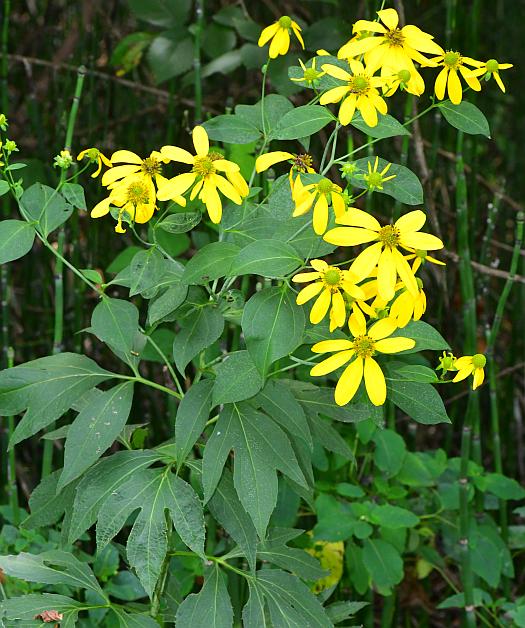Rudbeckia laciniata L.
Wild Goldenglow

Native
CC = 4
CW = -3
MOC = 54
© SRTurner
Rudbeckia laciniata L.Wild Goldenglow | |
 |
Native CC = 4 CW = -3 MOC = 54 |
© SRTurner |
|
Family - Asteraceae/Heliantheae Habit - Perennial forb with fibrous roots and often a somewhat woody rootstock. Stems - Erect, to 2.5 m, branching, single or multiple from the base, glabrous, often glaucous.
Leaves - Alternate, petiolate, reduced to bracts in inflorescence. Lower leaves mostly deeply lobed or deeply divided, sometimes fully compound, long-petiolate, the blade 15-50 cm long, 100-300 mm wide, ovate to broadly ovate in outline, the lobes ovate to elliptic or obovate, tapered to a sharply pointed tip. Median and upper stem leaves short- to long-petiolate, the uppermost leaves occasionally sessile and/or unlobed, the blade 3-40 cm long, 1-20 mm wide, the unlobed leaf blade or the lobes of a divided blade lanceolate to ovate to elliptic, tapered to a sharply pointed tip. Leaves mostly angled or tapered at the base, the margins otherwise entire or sharply finely to coarsely toothed, the surfaces glabrous or sparsely pubescent with short, stiff hairs, at least the upper surface smooth to the touch, both surfaces sometimes somewhat glaucous, green to grayish green when fresh.
Inflorescences - Loose, open clusters or leafy panicles of flowering heads. Peduncles to 15 cm long.
Heads - Radiate. Involucral bracts 8-15, 3-15 mm long, oblong-ovate to oblong-lanceolate or narrowly oblong, the outer surface and margins glabrous or moderately to densely and finely hairy, especially toward the base. Receptacle 15-20 mm long, 10-20 mm in diameter, spherical to broadly ovoid at the start of flowering, then elongating somewhat. Chaffy bracts subtending only the disc florets, shorter than to nearly as long as the disc florets, truncate, rounded or broadly angled to a short, bluntly or sharply pointed tip, the outer surface and margins with dense, short, often somewhat matted hairs, dull yellow to yellowish green.
Flowers - Ray florets 8-13, sterile, the corolla 20-45 mm long, usually relatively slender, angled downward or drooping at flowering, yellow, the outer surface sparsely short-hairy. Disk to 2 cm in diameter, conic to globose. Disc florets numerous, perfect, oriented in all directions, the corolla 3.5-4.5 mm long, dull yellow to yellowish green, the lobes ascending at flowering. Stigma lobes relatively short and bluntly to less commonly sharply pointed at the tip. Pappus a short, toothed crown 0.4-0.8 mm long. Stamens 5, adnate at the base of the corolla tube. Filaments yellow, compressed, glabrous, 2 mm long. Anthers deep purple, connate around the style, often exserted. Style exserted, bifurcate, the apices spreading, glabrous, pale yellow.
Fruits - Achenes 2.0-3.5 mm long. Flowering - July - September. Habitat - Bottomland and mesic forests, streambanks, pond margins, sloughs, roadsides. Origin - Native to the U.S. Lookalikes - Verbesina alternifolia. Other info. - This species is scattered to common throughout Missouri. The variety which grows in Missouri, var. laciniata, also occurs throughout the northeastern third of the continental U.S. It is recognized by its generally tall stature, characteristically lobed lower leaves, and yellow flower heads. The disk florets tend to be oriented in all directions on a hemispherical receptacle. The appearance of the inflorescences is similar to the lookalike Verbesina alternifolia, but that species does not produce lobed leaves.
Photographs taken in the Ozark National Scenic Riverways, Shannon County, MO., 8-2-03 (DETenaglia); also at Rocky Mountain National Park, Larimer County, CO, 7-30-2017, Little Lost Creek Conservation Area, Warren County, MO, 8-23-2017, Tyson County Park, St. Louis County, MO, 8-28-2017, and along the Katy Trail near Dutzow, Warren County, MO, 8-20-2021 (SRTurner). |